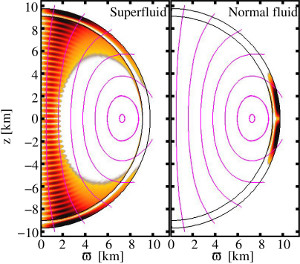|
|  |
Neutron stars are a very particular class of stars: they are the most
compact stars and they posses the strongest magnetic fields ever
observed. They are the final state of the evolution of massive normal
stars, i.e. once the fusion process ceases in the centre of such a
star, it explodes as a supernova and leaves a neutron star as a
compact remnant. But despite this fact, these stars cannot be
considered to be “dead”. Instead, they show high activity related to
their strong magnetic fields: emission of the most stable
electromagnetic pulses (radio pulsars) and repeated flares in X- and
gamma-rays (soft gamma-ray repeater/magnetars). Therefore, they are of
major interest for astrophysicists.
While the structure of the solid crust of neutron stars is well
constrained from terrestrial experiments, little is known about the
state of the matter in their interiors. Various theories predict a
different behavior of the core matter. Because neutron stars are held
together by very strong gravity their interior is so dense that these
conditions cannot be reproduced in any laboratory on Earth. Therefore,
observations of neutron stars provide the only opportunity to help us
understand the complex nuclear physics of very dense matter, and in
particular the interaction of fundamental particles under these
conditions.
"Starquakes" of neutron stars with extremely strong magnetic fields
(magnetars) may shed light into their exotic interior structure (
 see Highlight). In
past years, two giant flares were detected in the so-called soft
gamma-ray repeaters SGR 1806-20 (2004) and SGR1900+14 (1998).
During these events the emitted gamma-ray emission was modulated at
different frequencies. Some of
the lower oscillation frequencies discovered approximately match the
frequencies of magneto-elastic oscillations of magnetars. These
pulsations of neutron stars arise from the interaction of the magnetic
field in the core with elastic shear oscillations in the solid crust
that are similar to earthquakes. However, in this magneto-elastic
model the observed high frequencies could not be explained. see Highlight). In
past years, two giant flares were detected in the so-called soft
gamma-ray repeaters SGR 1806-20 (2004) and SGR1900+14 (1998).
During these events the emitted gamma-ray emission was modulated at
different frequencies. Some of
the lower oscillation frequencies discovered approximately match the
frequencies of magneto-elastic oscillations of magnetars. These
pulsations of neutron stars arise from the interaction of the magnetic
field in the core with elastic shear oscillations in the solid crust
that are similar to earthquakes. However, in this magneto-elastic
model the observed high frequencies could not be explained.
With recent numerical simulations, carried out by a collaboration
between researchers from the MPA, the University of Valencia and the
University of Thessaloniki, it is now possible to identify both low
and high frequencies consistently as magneto-elastic oscillations or
"starquakes". The crucial ingredient to match all observations at
once is another exotic property of the core matter: superfluidity. In
this state, there exists no viscosity in the fluid and it has infinite
thermal conductivity. On Earth, superfluidity can only be observed at
extremely low temperatures, and for just a few elements such as liquid
helium.
If one includes superfluid effects in recent neutron star models, only
a fraction of the matter (mainly the non-superfluid protons and
electrons) is participating in the magneto-elastic oscillations that
need to be matched to the observed frequencies. This decoupling leads
to a better agreement of our estimates of the magnetic field strength
of magnetars with alternative estimates. Moreover, a new family of
oscillations appears that is crucial for a complete interpretation of
the observed frequencies: a high-frequency shear mode in the crust
(that was damped in previous models without superfluidity) resonates
with a high overtone of the Alfvén oscillations in the core. (Alfvén
oscillations are magnetohydrodynamic waves that are caused by the
magnetic field acting as restoring force.) Additionally, superfluid
magneto-elastic oscillations should live longer than the oscillations
described by previous models, which is important for their detectability.
In future studies the new model can be used to further constrain the
state of the matter in neutron stars in general and its superfluid
properties in particular.
M. Gabler (MPA, Valencia), E. Müller (MPA), P.Cerdá-Durán (Valencia),
T. Font (Valencia) and N. Stergioulas (Thessaloniki)
Original Publication
Michael Gabler, Pablo Cerdá-Durán, Nikolaos Stergioulas, José A. Font, and Ewald Müller,
"Imprints of Superfluidity on Magnetoelastic Quasiperiodic
Oscillations of Soft Gamma-Ray Repeaters",
Phys. Rev. Lett. 111, 211102 (2013)
 http://de.arxiv.org/abs/1304.3566 http://de.arxiv.org/abs/1304.3566
|




